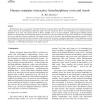Free Online Productivity Tools
i2Speak
i2Symbol
i2OCR
iTex2Img
iWeb2Print
iWeb2Shot
i2Type
iPdf2Split
iPdf2Merge
i2Bopomofo
i2Arabic
i2Style
i2Image
i2PDF
iLatex2Rtf
Sci2ools
JSS
1998
1998
Human-computer interaction: Interdisciplinary roots and trends
Methodology, theory, and practice in the ®eld of Human±Computer Interaction (HCI) all share the goal of producing interactive software that can be used eciently, eectively, safely, and with satisfaction. HCI is cross-disciplinary in its conduct and multidisciplinary in its roots. The central concept of HCI is usability, ease of use plus usefulness. Achieving good usability requires attention to both product and development process, particularly for the user interaction design, which should serve as requirements for the user interface software component. This paper reviews some of the theory and modeling supporting the practice of HCI, development life cycles and activities, and much of the practice that constitutes ``usability engineering''. Future application areas of interest in HCI include new interaction styles, virtual environments, the World Wide Web, information visualization, and wearable computing. Ó 1998 Elsevier Science Inc. All rights reserved.
| Added | 22 Dec 2010 |
| Updated | 22 Dec 2010 |
| Type | Journal |
| Year | 1998 |
| Where | JSS |
| Authors | H. Rex Hartson |
Comments (0)

